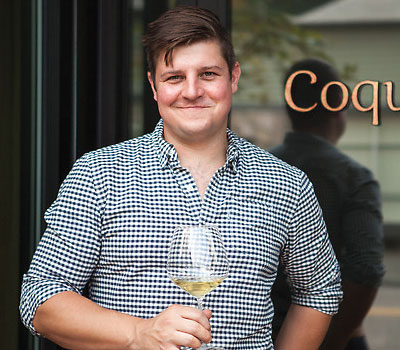Ksandek Podbielski and his wife, Katy Millard, run a small neighborhood restaurant, Coquine, in Portland’s Mt. Tabor neighborhood, which sounds as colloquial as a Portland restaurant can be. But, Millard has been a regular 2018 James Beard Nominee for Best Chef Northwest—in 2017 and 2018, as well as a 2019 semifinalist. The restaurant has proven to be not only a haven for original wine bottlings, but also a source for cutting-edge Oregon wines.


For a neighborhood restaurant, you have kind of an overachieving menu.
For dinner, we serve two coursed menus—one four-course and one seven-course—along with a la carte. About half of our guests opt for a set menu; I’d say about a third go for the seven-course, and two thirds for the four-course, and most of these go for wine pairings.
We have about 445 wines. I include anything and everything I can get my hands on when it comes to regions. The Pacific Northwest accounts for about 30 percent of the list. There’s still a spotlight on Oregon, but on other aspects—not just pinot noir. We have a whole page devoted to Oregon pinot, 25 options, but there’s so much more going on here that I want people to know about. My intention is to shine on the other varieties out there. Nebbiolo for instance. There are a few of them out there. Cameron makes Nebbiolo; John Paul (the winemaker for Cameron) planted it in 1995. I think about 60 cases of the 2014 were released, and I took a lot of it.
So, how do you sell Oregon nebbiolo?
I like to put other nebbiolos all around it on the page, including classics. I do the same with albarino.
The best way to describe Portland diners is that they’re a very dynamic, savvy, evolving group. There’s a joke about Portland wine drinkers where you can’t pay them enough not to drink a $15 glass of Italian wine, but the natural wine explosion was pretty timely; we’ve got people inquiring about orange wines, natural wines.
Is it a millennial thing?
Not exclusively. Some folks are in their 50s and 60s and they’re looking to understand the trend. I think there’s a more adventurous spirit now across the board, and it may be the result of natural wine. That’s the thing. The term is problematic, but it no longer describes what the intent was at outset of movement. But, it has changed the dialogue. Folks are interested in trying different things.
The biggest success this year was a Croatian plavac mali? Why, do you think that is?
Well, it’s delicious. Stylistically, it’s very accessible, it has great fruit, and it’s approaching a weightier and fuller wine in terms of style. And, aromatically it has a lot going on. For crowd-pleasing you can’t really get much better than that; plus it’s a little adventurous, coming from Croatia, a comfortable wine, but from a place maybe they’ve never had before. The price is also comfortable, so some people order a second bottle.
What else seems to be trending?
We sell a lot of half bottles. We’ve made a commitment to them in our program, about 40 selections. They’re really great for solo diners, and people like them at lunch, they feel comfortable ordering them, when they’re needing to be modest I guess. People will get two half bottles but are timid to get a full bottle, even though the pricing with half bottles is always more than half the full price. I’ve heard the thought process that people don’t like the idea of being wasteful; but also, if they’re going to try something new there’s less hesitation.
There’s continued interest in Champagne. We have a great selection, and we continue to see diners interested to drink it with the first part of their meal, and then also with their meal. I think Katie’s cooking lends itself to Champagne. The flavors are lighter, brighter. They’ve got lots of acidity and are properly seasoned; we don’t get a lot of big flavor though fat.
We continue to champion Oregon chardonnay. We carry and sell a lot of Bergstrom’s chardonnay, Sigrid, Belle Pente, and some older Eyrie, as well as Crowley and Cameron. The other chardonnay that sells is Statera; they’re an outlier, reductive, with lots of acidity and texture. Luke Wylde and Meredith Bell (of Statera) are also making a wine from the state’s oldest aligoté, which I carry. We’ve gone through a ton of that.
Patrick J. Comiskey covers US wines for Wine & Spirits magazine, focusing on the Pacific Northwest, California’s Central Coast and New York’s Finger Lakes.
















